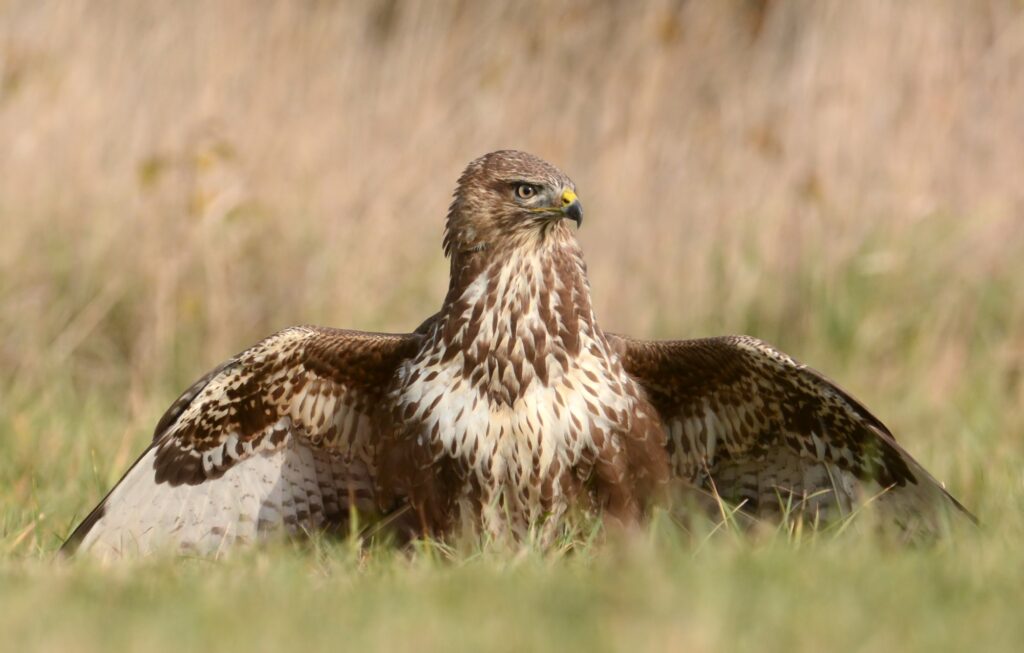Oklahoma, where the wind comes sweeping through the plains and nearly 500 bird species, ranging from crows and sparrows to Mexican Violetear, come soaring through the sky. With its wildlife refuge areas, parks, lakes, birding trails, and Black Mesa Preserve, this state is the perfect spot to revel in nature and the creatures that inhabit it.
Among the birds in Oklahoma are hawks; they’re fierce, colorful, and mesmerizing to watch. Sadly, most of the time, all we get are fleeting looks at the birds of prey. So, whether you’re an expert birdwatcher or you’re fairly new to the whole ordeal, it’s important to consult a field guide (and our handy dandy list, of course) to help you pinpoint each hawk species from a glance.
To help you get in the spirit of your birdwatching adventure, we’re sharing the nine species of hawks in Oklahoma with you to help you know exactly what to look for.
Red-Tailed Hawk
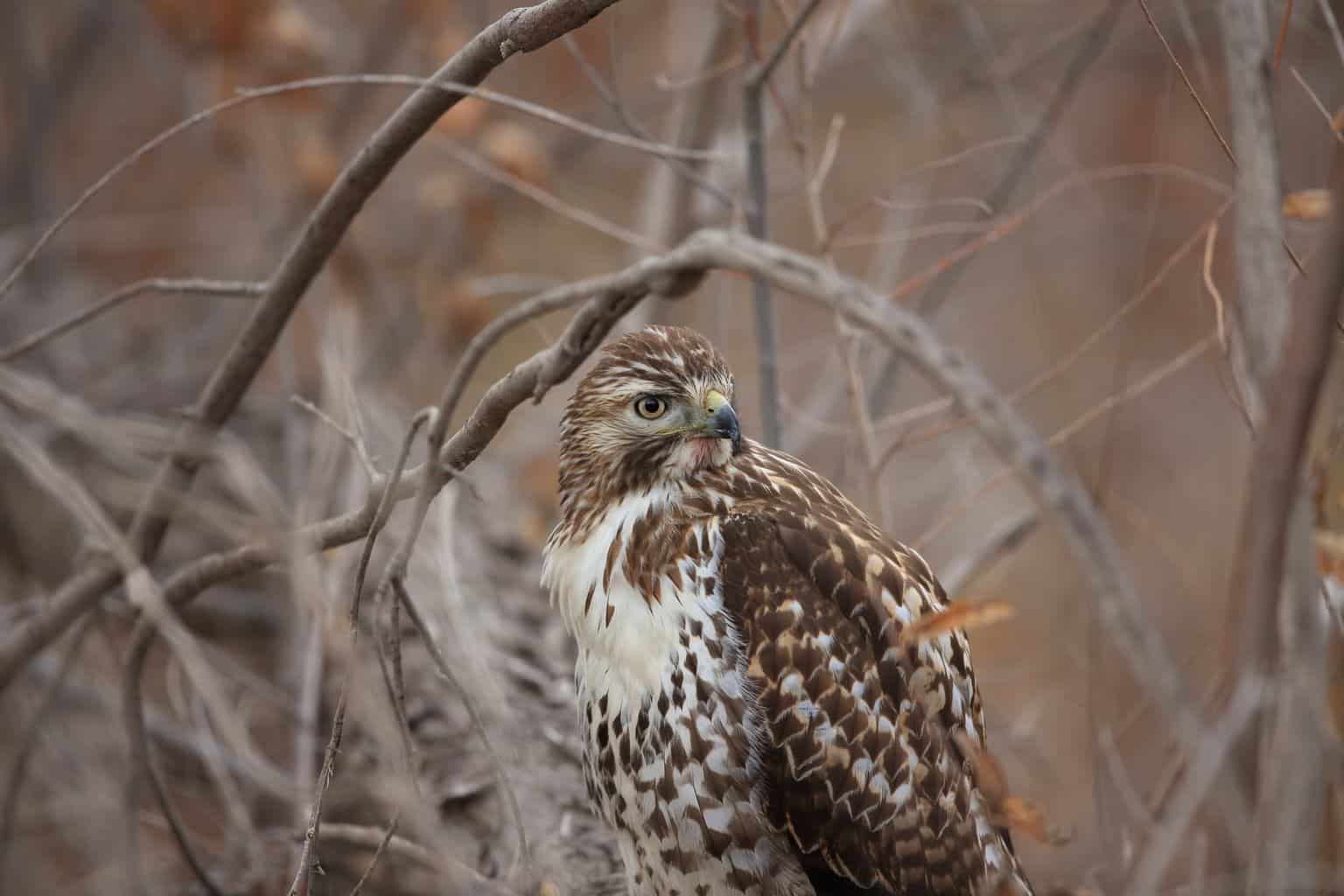
- Scientific name: Buteo jamaicensis
- Length: 18-25 inches
- Weight: 2-4 pounds
- Wingspan: 45-52 inches
The red-tailed hawk, sharp-shinned hawk, and Cooper’s hawk all have the shameful reputation of preying on chickens. Although for the latter types of hawks it’s well-deserved, the former, the red-tailed hawk, is innocent of these charges.
The red-tailed bird of prey is so commonly seen in Oklahoma, it’s recognized as the state’s raptor. It’s considerably bulky in size with a copper-red head, nape, shoulders, and of course, tail. The tips of its white wings are black, and they extend to the beginning of the tail. And while the red-tailed hawk’s body is white, its back is a basic shade of brown that gives a coppery tint when in the light. A dark morph of this species is dark brown except for its greyish wings and tail, which are both dark at the tips.
Sharp-Shinned Hawk
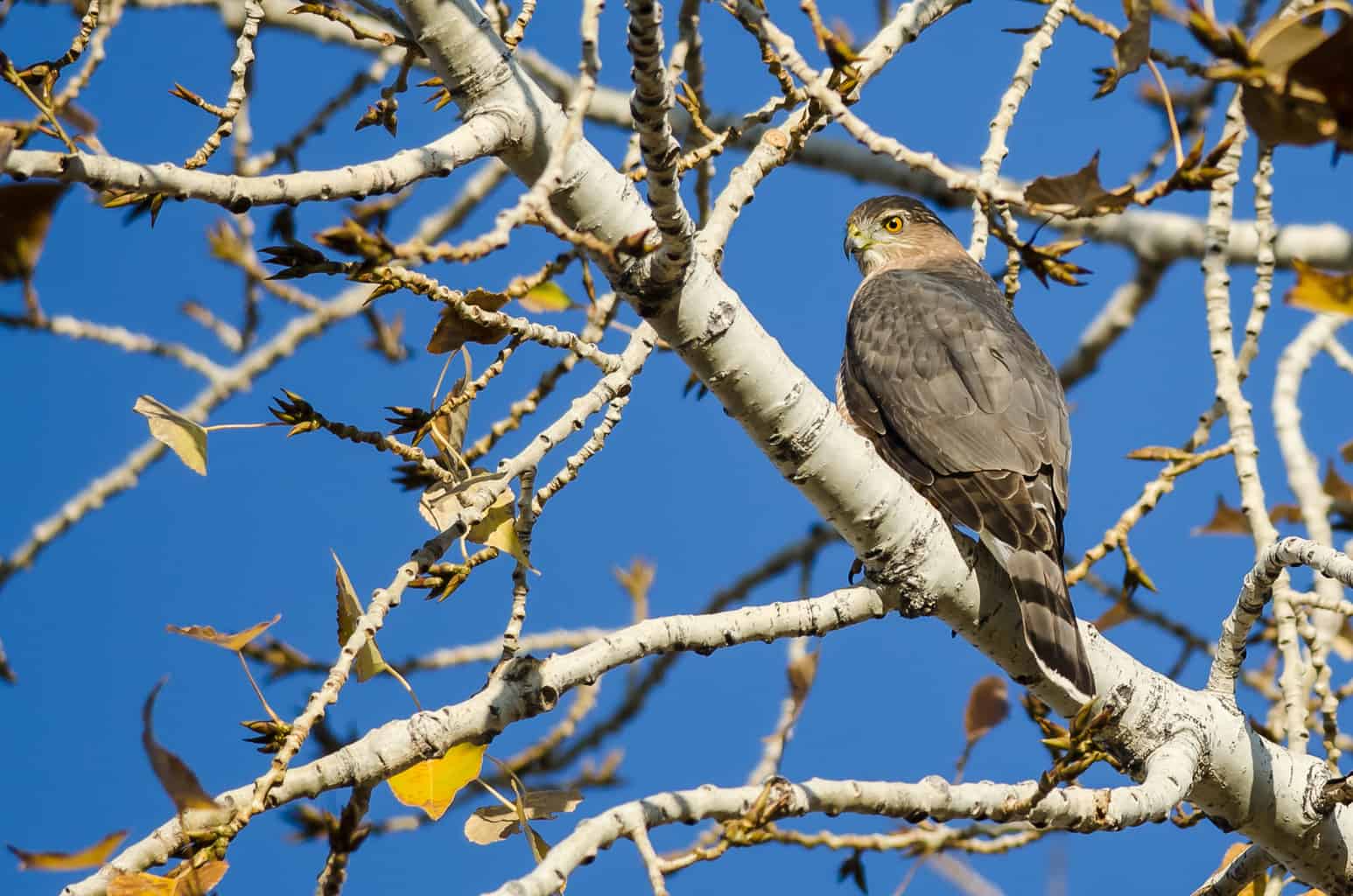
- Scientific name: Accipiter striatus
- Length:10-14 inches
- Weight: 0.5 pounds
- Wingspan: 20-28 inches
The sharp-shinned hawk is dainty in size — the smallest of the North American hawks — and has yellow eyes that turn red as it matures. Their backs are stormy sea-gray, and their fronts are reddish-brown with white crescents crowded together. As for their tails, they’re white with black bars.
This bird lives in dense forests and builds its nest at the very top of the trees. When winter falls, they usually spend the season in North America, however, it’s not uncommon for some of them to migrate to the South Indies or Central America. They typically migrate alone, but occasionally, they join other groups of sharpies, red-tailed, or broad-winged hawks.
Cooper’s Hawk
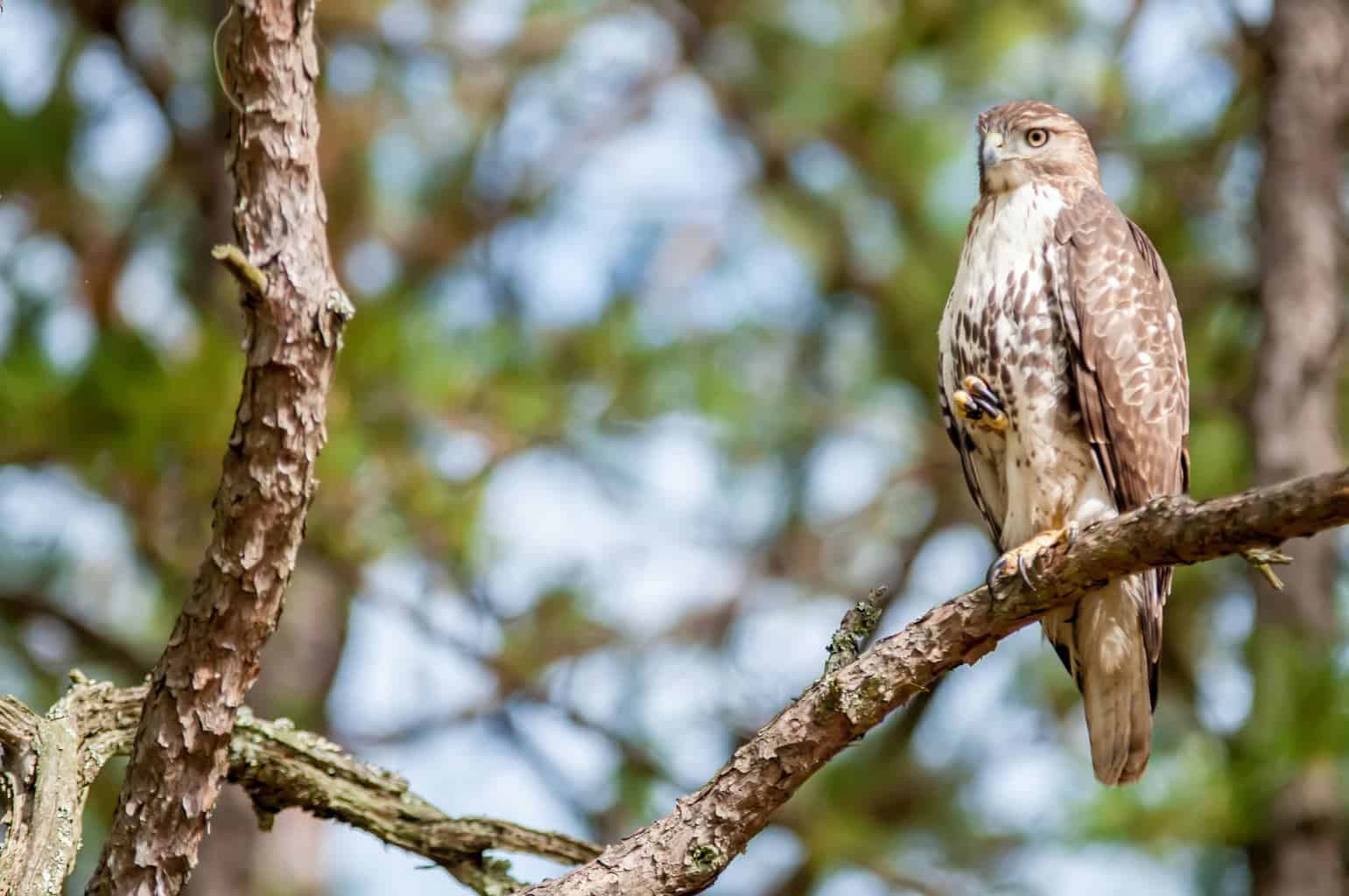
- Scientific name: Accipiter cooperii
- Length: 14.6-17.7 inches
- Weight: 1.16 pounds
- Wingspan: 24.4-35.4 inches
The plumage, size, and even eye color of Cooper’s hawk are very similar to those of the sharp-shinned bird above. This is why it’s easy to confuse the two. If you’re looking to tell them apart, check out their heads; that of the Cooper’s bird is bigger and less rounded. The tail is another main indicator of who’s who, as Cooper’s hawk’s tail is rounded at the tip while the sharp-shinned hawk’s is more rectangular.
While both birds of prey prefer to live in dense forests, Cooper’s hawks are also satisfied in parks, backyards, and even quiet streets with scattered trees. Their presence in your backyard is probably thanks to the small birds that may be visiting your bird feeders.
This species attacks at the other birds’ most vulnerable time: when they’re feeding. This same deviousness goes for the sharp-shinned hawk, too, so put cages around the feeders so they’re out of reach from larger birds or remove them for a week or two if you spot this predator nearby. Don’t worry; the little birds will find you when you put them up again. Always make sure your yard is free of insects and rodents, as you don’t want further temptation for the predatory birds.
Ferruginous Hawk
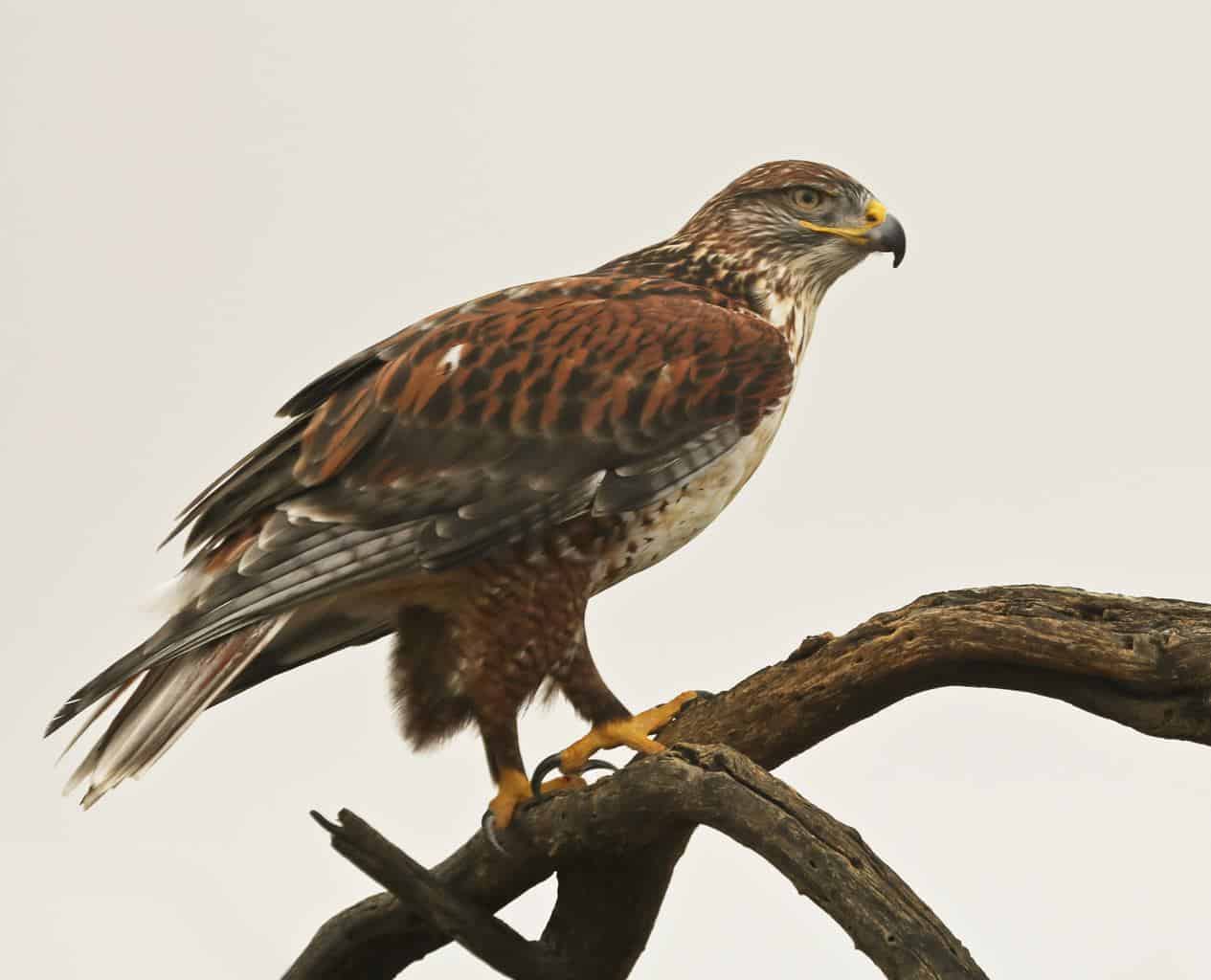
- Scientific name: Buteo regalis
- Length: 20-26 inches
- Weight: 3.3 pounds
- Wingspan: 53-60 inches
The ferruginous hawk has a long protruding face with a bright yellow gape that reaches the hawks’ piercing eyes. The feathers on its back and head are rust-colored, matching the feathers that grow down its legs. It and rough-legged hawks are the only two hawk species that boast this characteristic.
In contrast, the hawk’s front, tail, and wings are snow-colored. There are, however, some black and brown feathers scattered among ferruginous hawks’ broad wings, as well as a bit of black at the tips. Though less commonly sighted, a small percentage of this species’ population are dark morphs, so they’re chocolate and hazel colored with a full-on white tail and white flight feathers.
You can catch them taking flight in all seasons, and their nests can be anywhere from deserts to plains and prairies.
Swainson’s Hawk
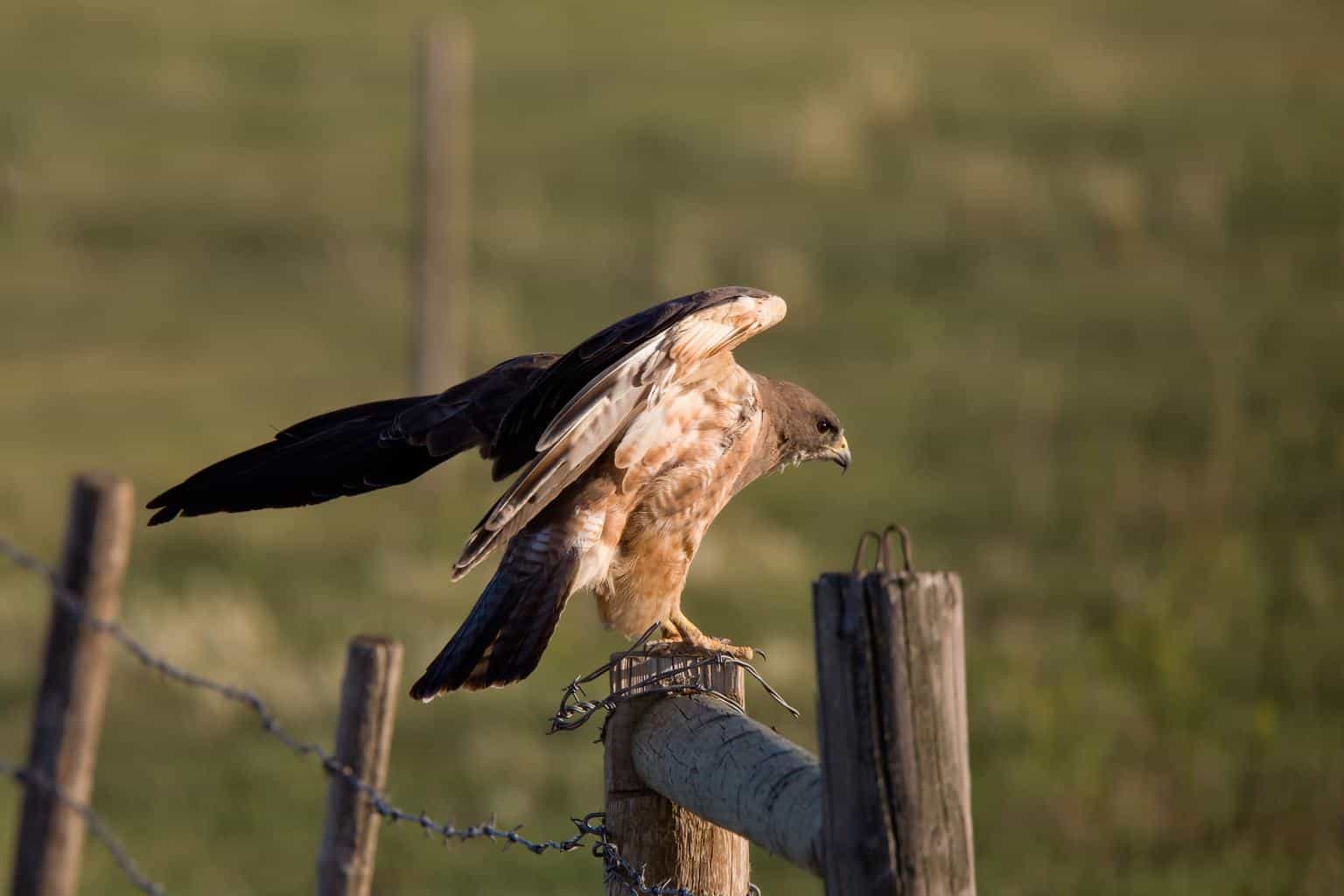
- Scientific name: Buteo swainsoni
- Length: 18-22 inches
- Weight: 1.8-2.5 pounds
- Wingspan: 47-57 inches
Swainson’s hawk has a white speckled body with a brown bib around the neck. While its back and head are black, the wings are white, except for the graded black at the flight feathers.
Its migration journey is by far the longest one that hawks make. It’s to the lands of Argentina, and it’s not without company. They all fly together in groups of hundreds or even thousands of hawks.
Swainson’s birds feed on rodents, rabbits, and reptiles. However, grasshoppers are among their favorite meals, so they’re widely known as the grasshopper hawks.
Broad-Winged Hawk
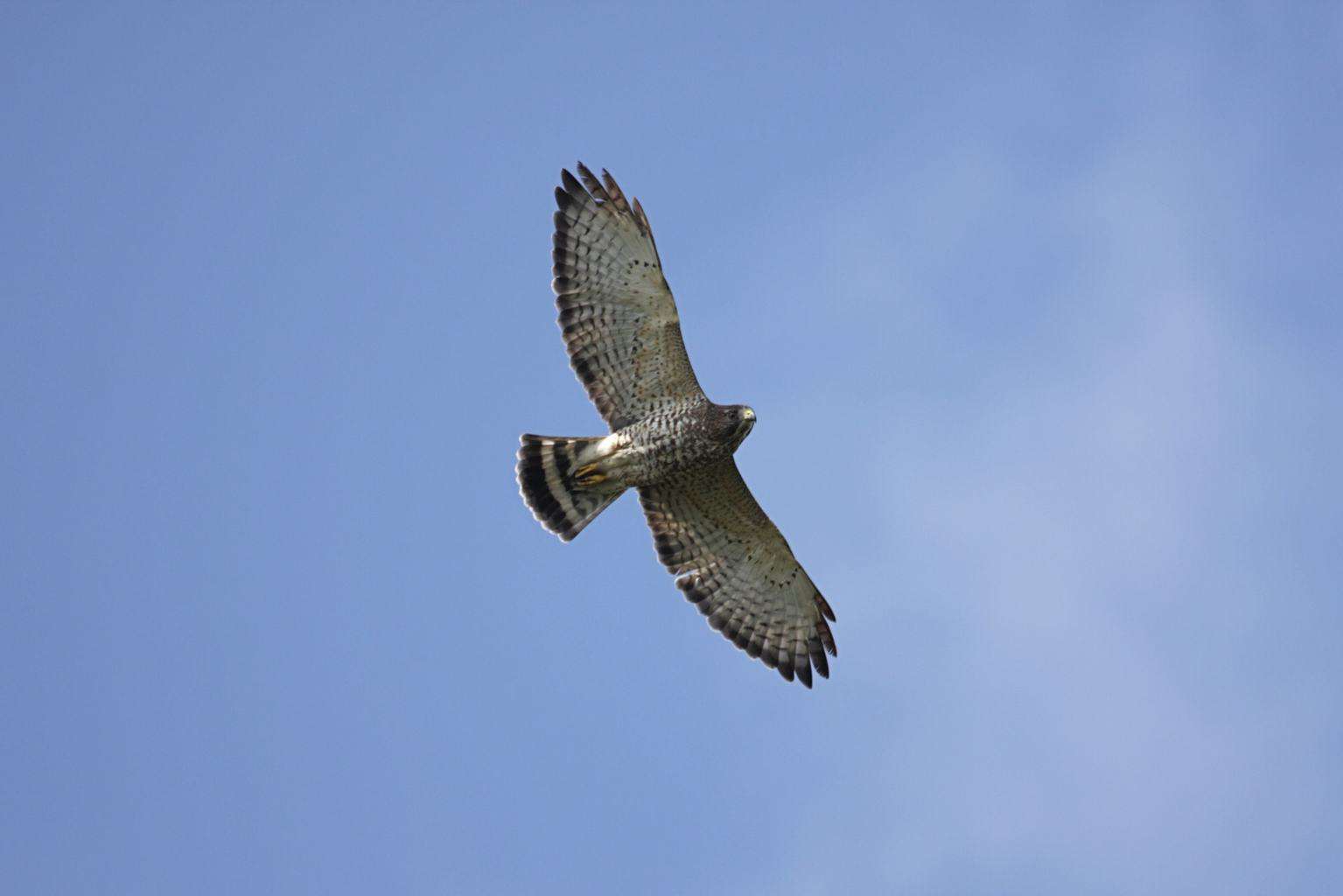
- Scientific name: Buteo platypterus
- Length: 13.4-17.3 inches
- Weight: 1 pound
- Wingspan: 32-39.4 inches
You’ll spot broad-winged hawks by their off-white and brown barred chests and cream-colored shoulders that are flecked with brown dots.
On the other hand, their tails and the primary and secondary wings are all white with black bands. The wings’ black tips take on a rectangular shape when the hawk is perched.
Like the Swainson’s hawks, the broad-winged ones are long-distance migrants too. They spend the winter in forests at the edge of southern Mexico and Brazil.
Northern Goshawk
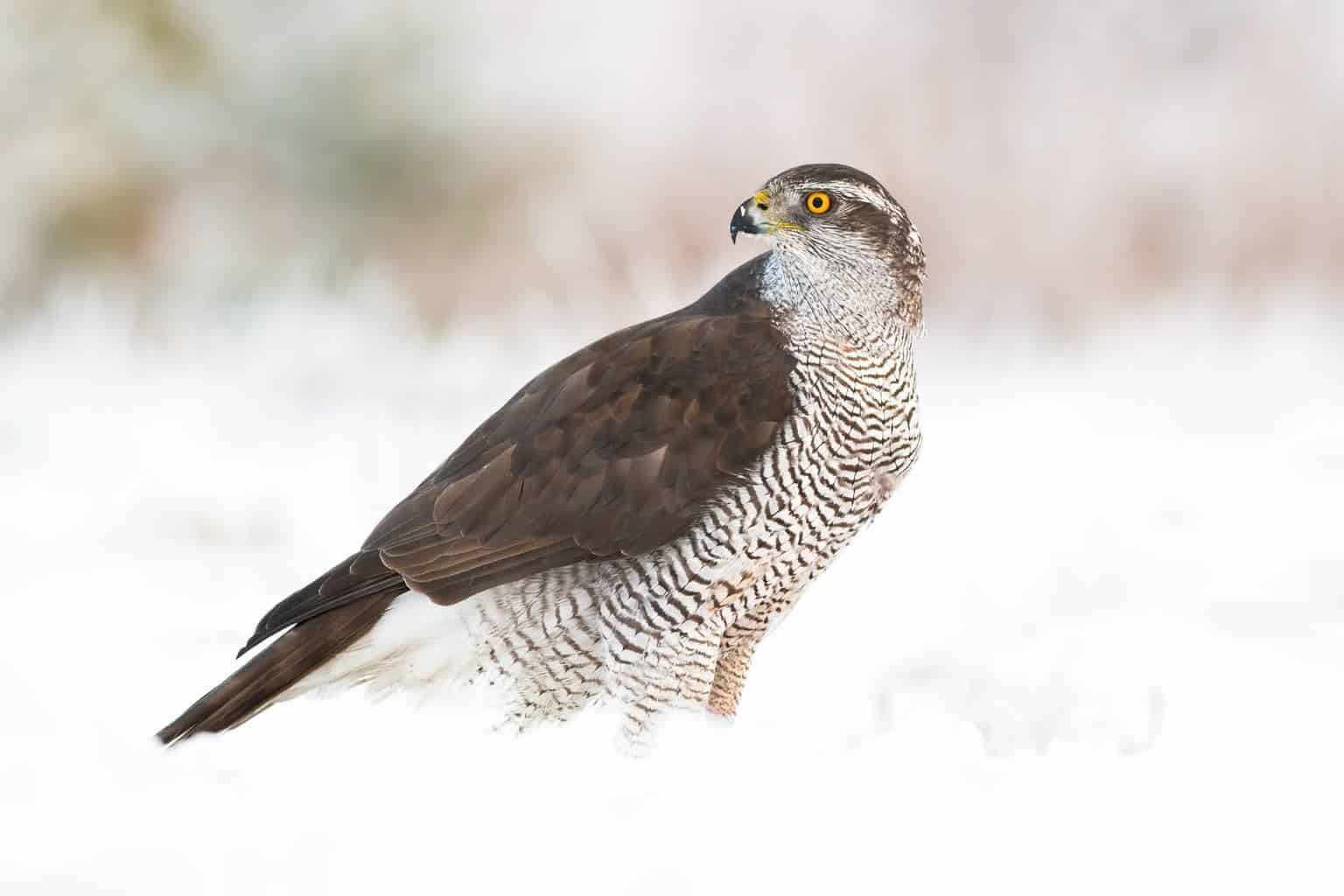
- Scientific name: Accipiter gentilis
- Length: 18-27 inches
- Weight: 1.1-4.85 pounds
- Wingspan: 37-50 inches
The northern goshawks have unique plumage, making them easy to identify…that is if you’re lucky enough to find them in the first place!
These secretive birds live deep in coniferous forests and will attack any human or animal that sneaks towards their nest. They steer clear of people, so the chance of spotting one of them is pretty slim.
Should you encounter one of these birds, you’ll be able to identify it by its daring red eyes and grey head and back. The grey head has two white streaks for eyebrows, giving it an even more edgy and distinctive look. The hawk’s front is white with black horizontal stripes all over the shoulders and chest area, and as for the flight feathers and tail, they’re light grey with narrow black bands.
As juveniles, these accipiter hawks are speckled with brown and have distinct pale eyebrows.
Rough-Legged Hawk
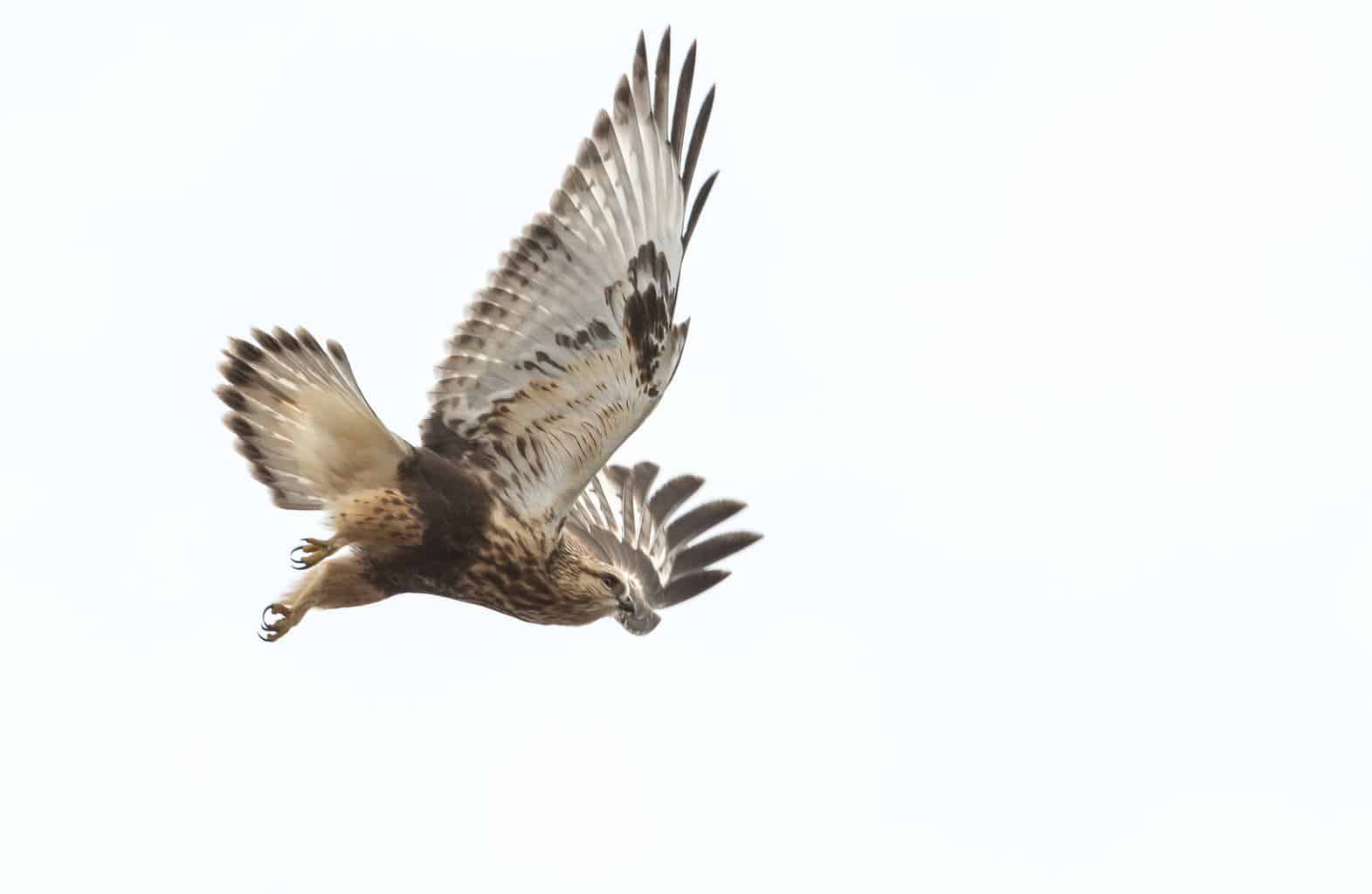
- Scientific name: Buteo lagopus
- Length: 18.5-20.5 inches
- Weight: 2 pounds
- Wingspan: 52-54 inches
If a rough-legged hawk is flying overhead, you’ll see its white body with heavy brown spotting all over, and you’ll probably notice that the edges of the bird’s wings and tail fan out all in white…except for their black tips.
A juvenile white morph of the rough-legged hawk, on the other hand, is butter-colored with a wide brown band at the belly and blotches of brown on the chest. The tips of the tail and wings are light gray.
The rough-legged hawk is the only hawk species besides ferruginous hawks to have feathers reaching down to their talons. The purpose of the feathered legs is heat conservation. This physical trait conveniently helps them breed in the arctic tundras of North America, Asia, and Europe.
They typically migrate in small groups or each on its own. Nonetheless, they can be seen sometimes in large flocks. Rough-legged hawks are also skilled hunters, famous for smoothly swooping in and stealing the freshly caught prey of the northern harrier.
Red-Shouldered Hawk
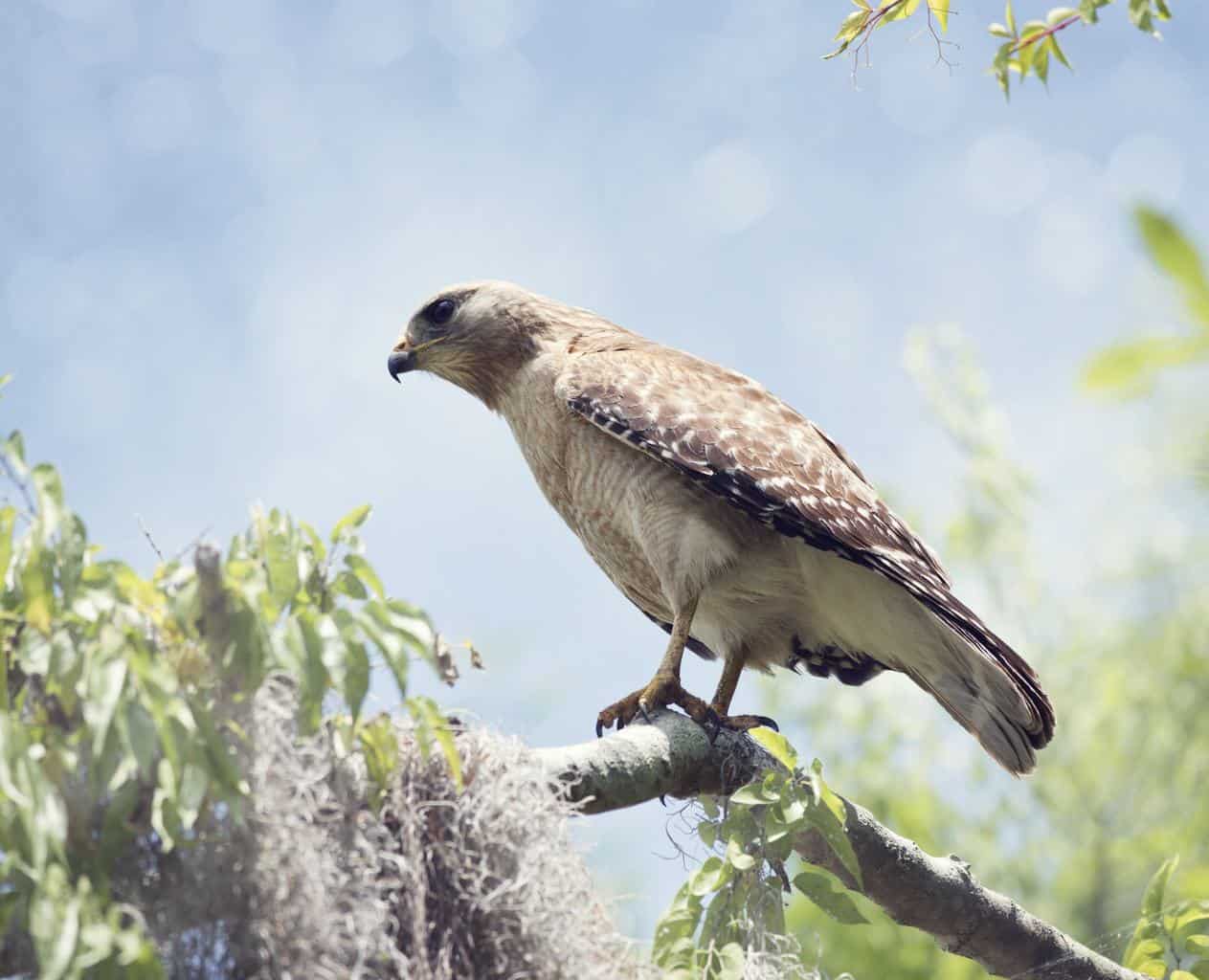
- Scientific name: Buteo Lineatus
- Length: 17-24 inches
- Weight: 1-1.7 pounds
- Wingspan: 37-43.7 inches
While out birdwatching, look out for the red-shouldered hawk and its marigold chest that’s marked with tiny red crescents and white wings, back, and tails that are barred with brown — almost black — feathers.
Red-shouldered hawks generally migrate alone, but they sometimes form small groups for the company. They don’t usually travel for long distances, however, some might wander as far as Mexico. You’ll likely find them spending the winter in the southeastern United States.
During other times of the year, they’re easy enough to find as they fly around the trees, rivers, and swamps in eastern Oklahoma woods. They sometimes make their homes near farmlands, so if you find yourself in one of those areas, keep your eyes peeled.
They don’t fly out as much as other species but rather stay perched on tree branches, so make sure your gaze is to the sky. They also always go back to their nests and territory year after year, so if you’ve seen a red-shouldered hawk in one location, you’ll have a good chance of seeing it there again.
Wrap Up
Identifying hawks is fun, although it can definitely be tricky. Try to look out for the unique attributes in each. For example, you can check the talons to see whether they’re feathered or not. Check the tail when the hawk is perched to see if it’s rounded or more rectangular. Look at the size; some hawks like the sharpie and Cooper’s hawks, for instance, are distinctively small. Most obviously, look closely at the feathers’ colors. You don’t need a hawk’s eye to tell them apart.
If the hawks of Oklahoma ignite a passion for birds in you, you won’t want to miss out on getting to know the tiny-billed woodpeckers there. Their plumage is no less vibrant, and their nests could be right in your backyard!

